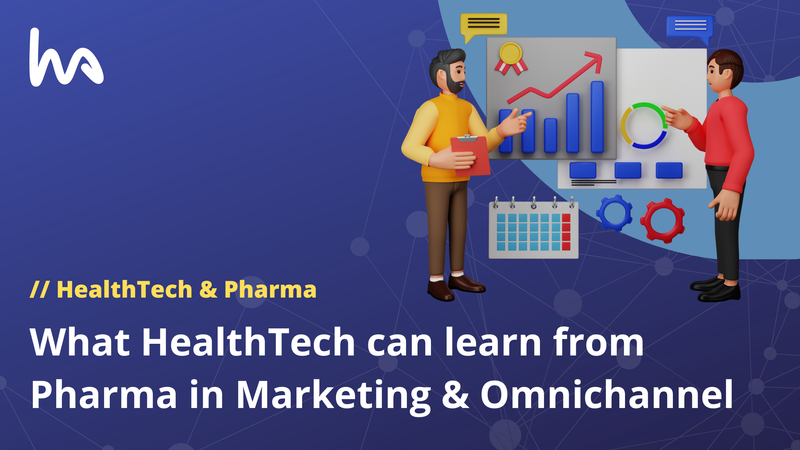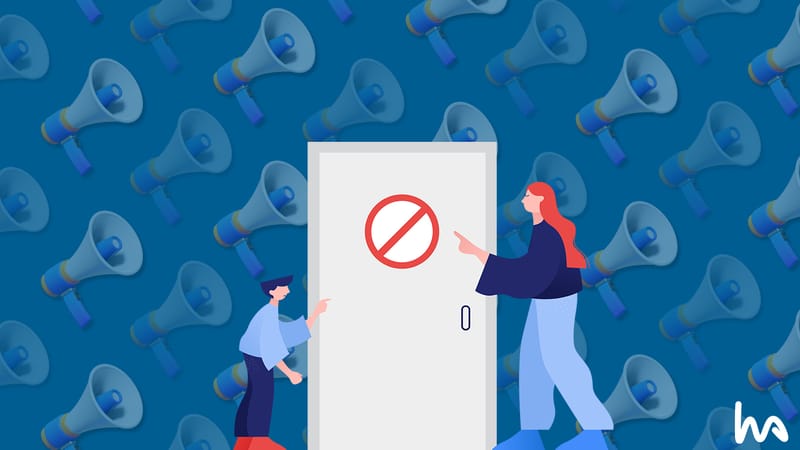Picture this: You’re an oncologist trying to catch up on the latest developments and best clinical practices to treat patients using CAR T cell therapy.
With a cup of steaming coffee in hand, you settle into your chair, ready to take a deep dive. But as you start clicking through websites, a sense of frustration washes over you. Clunky navigation, outdated information, and a lacklustre user experience leave you feeling underwhelmed and disengaged. It's like trying to find a needle in a haystack, and you can't help but wonder, "Why aren't more pharma websites hitting the mark?"
The digital landscape is teeming with websites that fall short of delivering the impactful experience visitors crave. That’s why, in today’s blog post, I’m talking about the vital ingredients at a high level for transforming your pharma website from a bunch of bland cookie-cutter pages to a gripping experience for every visitor that lands on it.
In my upcoming posts in this series, I will be sharing more detailed action items for each of the points mentioned below so stay tuned for those by subscribing to my newsletter!
Is it Worth the Effort?
Developing a new website or even a makeover is not a light undertaking. It demands significant effort, time, and money to have a stellar website.
So the question is, “Is it worth all this?”
And I’d say yes it absolutely is worth the resources that’ll go into it. In my opinion, it may even be a make-or-break kind of decision for your pharma business. Not having a website or not having a good one means pushing yourself into oblivion.
Before delving into the key elements of a winning pharma website, let's take a moment to highlight why having a strong online presence is so vital in the pharmaceutical industry.
A well-crafted website acts as your brand and product's digital ambassador. It establishes credibility, fosters trust, and serves as a primary touchpoint for potential customers, healthcare professionals, patients, investors and other stakeholders. In an era of information overload, a compelling website is your opportunity to stand out, differentiate your brand, and drive meaningful engagement.
So, grab another sip of your coffee and get ready to discover the elements that will turn your pharma website into a roaring success. From captivating content and thought leadership to easy access to clinical data, interactive tools, and seamless user experience, I’ll try to cover all the important elements of a website that helps you achieve digital excellence.
Elements of a Winning Pharma Website
i. Content is (still the) King (and always will be!):
Engaging and informative content is the lifeblood of your pharma website. It should address your target audience's specific needs and pain points, whether they are healthcare professionals, patients, industry stakeholders or investors. Craft compelling resources, articles and even blog posts that provide valuable insights, educational content, and solutions to your target audience’s pain points.
But this shouldn’t be so difficult - In my future blog post, I will be discussing the use and implementation of Modular content across a pharma companies ecosystem and how this can significantly enhance the process of content creation and publishing.
ii. Offer Interactive Tools and Resources: Enhance user engagement and provide added value by incorporating interactive tools and resources on your website, wherever possible. Consider developing dosage calculators, medication interaction checkers, symptom trackers, or patient education modules. These tools empower users with personalised information, facilitate decision-making, and encourage longer sessions on your website. Interactive resources can also serve as effective lead-generation tools by capturing user information for future engagement.
iii. Focus on UI & UX: User interface (UI) and user experience (UX) are critical to your website's success. Ensure that your website is visually appealing, intuitive to navigate, and optimised for various devices and screen sizes. Implement clear and logical site architecture, intuitive menus, and prominent calls-to-action to guide visitors through their journey. Pay attention to page loading times, accessibility and mobile responsiveness. Conduct usability tests to gather feedback and make iterative improvements to enhance the overall user experience.
iv. Make it Easy to Contact: Make it effortless for visitors to contact your team or seek further information - especially the HCP’s. Provide multiple contact options, including a contact form, email address, and phone number, where possible. Have you considered use of chatbots? I know what you’re thinking - a regulatory nightmare! BUT, done correctly, can be an intuitive way for your HCP to connect with you MSL.
v. Global web and design system libraries to enable localisation: One size doesn’t fit all anymore. Localising your website's content to cater to regional preferences and linguistic nuances. This involves adapting regulatory requirements, language, tone, and cultural references to resonate with the local audience. Localisation can create a more personalised and relatable user experience, enhancing engagement and building stronger connections with your target demographic.
I have been fortunate enough to help design, develop and deploy such systems with a whole range of learnings which I look forward to sharing in a whole blogpost of its own!
vi. Comply with Regulatory Guidelines: The pharmaceutical industry is highly regulated, and adherence to regulatory guidelines is paramount for your website. Ensure your website meets all applicable regulations, including data protection laws, medical advertising guidelines, and industry-specific compliance standards. Clearly display the PI, SMPC, important disclaimers, copyright notices, and privacy policies to demonstrate your commitment to transparency and compliance. Regularly review and update your website to align with any new regulatory requirements or changes, ensuring that your online presence remains compliant and trustworthy.
By prioritising compliance with regulatory guidelines, you mitigate legal risks and build credibility and trust among your audience. Compliance instills confidence in healthcare professionals, patients, and stakeholders who rely on accurate and trustworthy information from your website. Regularly consult legal experts to stay updated on the evolving regulatory landscape and ensure that your pharma website adheres to the highest standards of compliance.
Remember, regulatory compliance is not just a legal obligation but also an opportunity to demonstrate your commitment to ethical practices and patient safety. Embrace compliance as a cornerstone of your website strategy and establish your brand as a trusted and responsible member of the pharmaceutical industry.
vii. A simple yet effective HCP Verification process: In the pharma industry, it's crucial to ensure that the information and resources on your website are accessible only to verified healthcare professionals (HCPs). Implement a robust HCP verification process, in compliance with country-specific guidelines, to protect sensitive data and maintain compliance with industry regulations. This step not only enhances the credibility of your website but also fosters trust among HCPs seeking reliable information. I’m currently working on a global HCP verification guideline article. If you’re interested, drop me a line at hi[at]hussainahmad.co.uk, and I’ll make sure it reaches you while it’s fresh.
viii. Robust Security and Privacy Measures: Given the sensitive nature of pharmaceutical data, it's essential to prioritise security and privacy on your website. Implement robust measures such as encryption protocols, firewalls, secure server hosting, and regular security audits to safeguard user data, protect against cyber threats, and instill confidence in your audience.
ix. Pay Attention to Analytics: Data is a powerful ally when it comes to optimising your pharma website. It’s crucial to focus on the right data analytics for maximum ROI. Implement web analytics tools to track key metrics such as traffic sources, user engagement, conversion rates, and bounce rates. Analysing this data provides valuable insights into user behavior and helps you identify areas for improvement, refine your content strategy, and optimise the user experience for maximum impact.
x. Think omnichannel - Bring it all together: In the dynamic landscape of the pharmaceutical industry, an effective omnichannel strategy has become paramount, and websites play a pivotal role in its successful execution. These digital platforms serve as the cornerstone, seamlessly integrating various channels such as social media, email, mobile apps, and physical MSL interactions. Pharmaceutical companies can leverage their websites to provide comprehensive product information, engage with healthcare professionals and patients through informative blogs and webinars, offer personalised experiences through user accounts, and even facilitate online orders.
A well-designed website ensures consistent messaging and branding across all touchpoints, enhancing customer trust and loyalty. By harnessing the power of websites within your omnichannel approach, you can bridge the gap between virtual and physical interactions, fostering stronger connections and delivering valuable resources to across your audience.
Consider which interactions on your website can be utilised to build your user's profile and initiate or trigger the next step of your omnichannel funnel.
Don'ts of a Winning Pharma Website:
While we've covered the essential elements of a successful pharma website, it's equally important to be aware of the pitfalls to avoid. Here are the top three no-nos that can gut your website's effectiveness:
Don't Neglect Mobile Optimisation: With the increasing use of smartphones and tablets, mobile optimisation is no longer optional—it's a must. Failing to optimise your website for mobile devices can lead to a poor user experience, high bounce rates, and missed opportunities to engage with your audience. Ensure that your website is responsive and functions seamlessly across different screen sizes.
Don't Overlook SEO: A beautifully designed website is pointless if it's not easily discoverable by search engines. Neglecting SEO best practices can hinder your website's visibility and organic traffic. Conduct thorough keyword research, optimise your meta tags, incorporate relevant keywords into your content, and build high-quality backlinks to improve your search rankings and attract targeted traffic. Once again, don't forget regulatory compliance. Be sure to submit your keywords, meta tags, and description as part of your MRC / PMRT reviews.
Don't Skimp on Security and Privacy: In an era of heightened cybersecurity threats, it's critical to prioritise the security and privacy of your users' data. Failure to implement robust security measures can damage your reputation, compromise customer trust, and even result in legal repercussions. Invest in SSL certificates, encryption protocols, regular security audits, and user data protection mechanisms to safeguard sensitive information.
Conclusion
Crafting a winning pharma website is an art that requires careful consideration of multiple factors. I’ve covered the top drivers of engagement and trust when it comes to a pharma website.
By keeping your target audience at the forefront of your mind and considering the points discussed in this article, you can create a powerful online presence that sets your pharma brand apart from the competition.
Remember, your website is not just a digital asset; it's a reflection of your brand's values, expertise, and commitment to serving the needs of healthcare professionals and patients. Continuously monitor, analyse, and optimise your website to ensure it evolves with the ever-changing pharma landscape. Embrace innovation, embrace user-centric design, and embrace the opportunity to make a lasting impact in the digital realm of the pharmaceutical industry.
P.S. As mentioned earlier, this is the first of my posts in my series of posts on ‘Unlocking the power of pharma websites”. I’m planning a whole bunch of follow up blog posts on the points mentioned above, but if you have a specific question on how you can improve your pharma website, be it your corporate site, HCP portal or a patient advocacy platform, drop me an email on hi[at]husainahmad.co.uk or book in on a free 30 minutes call for us to discuss further.





